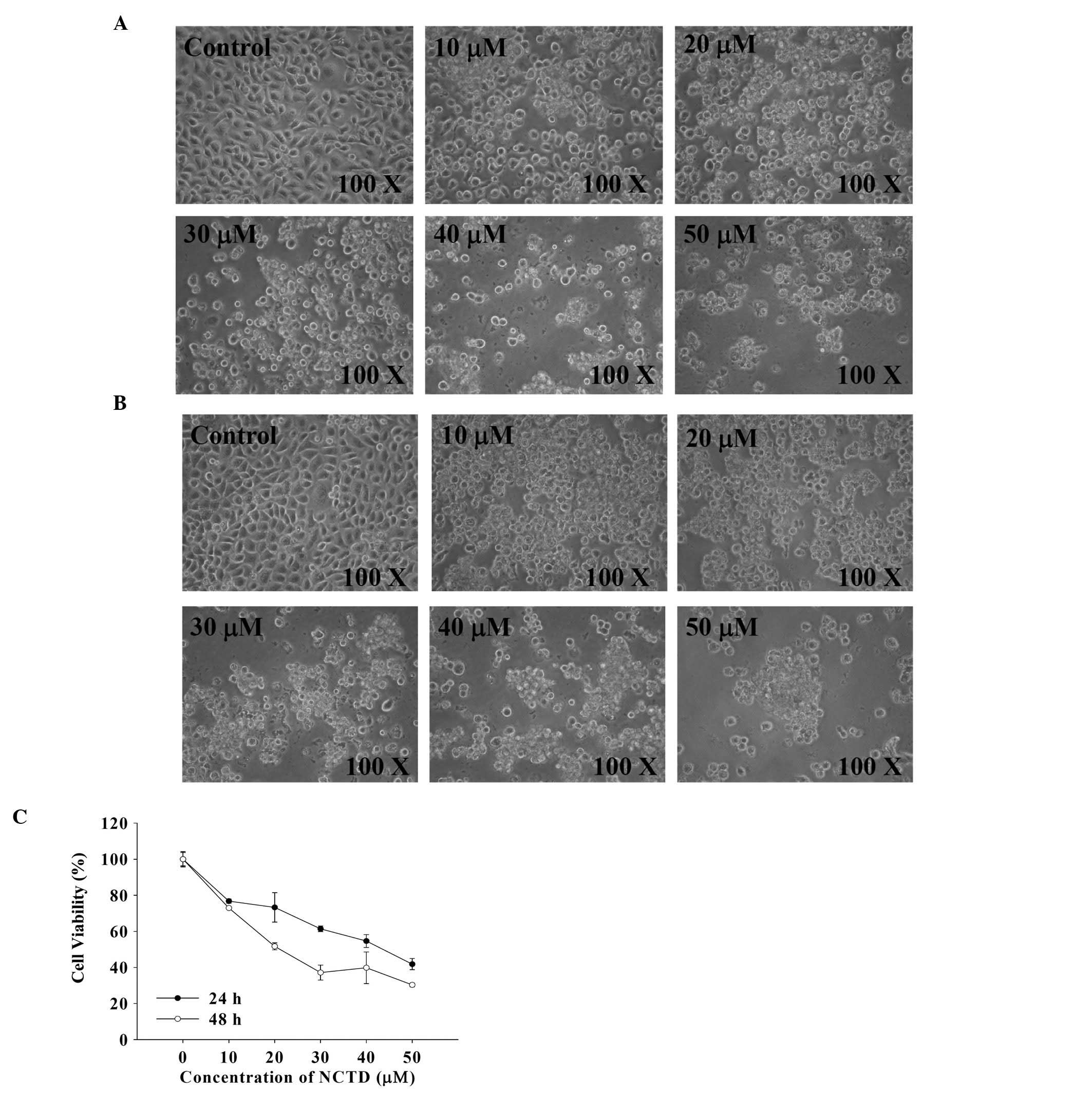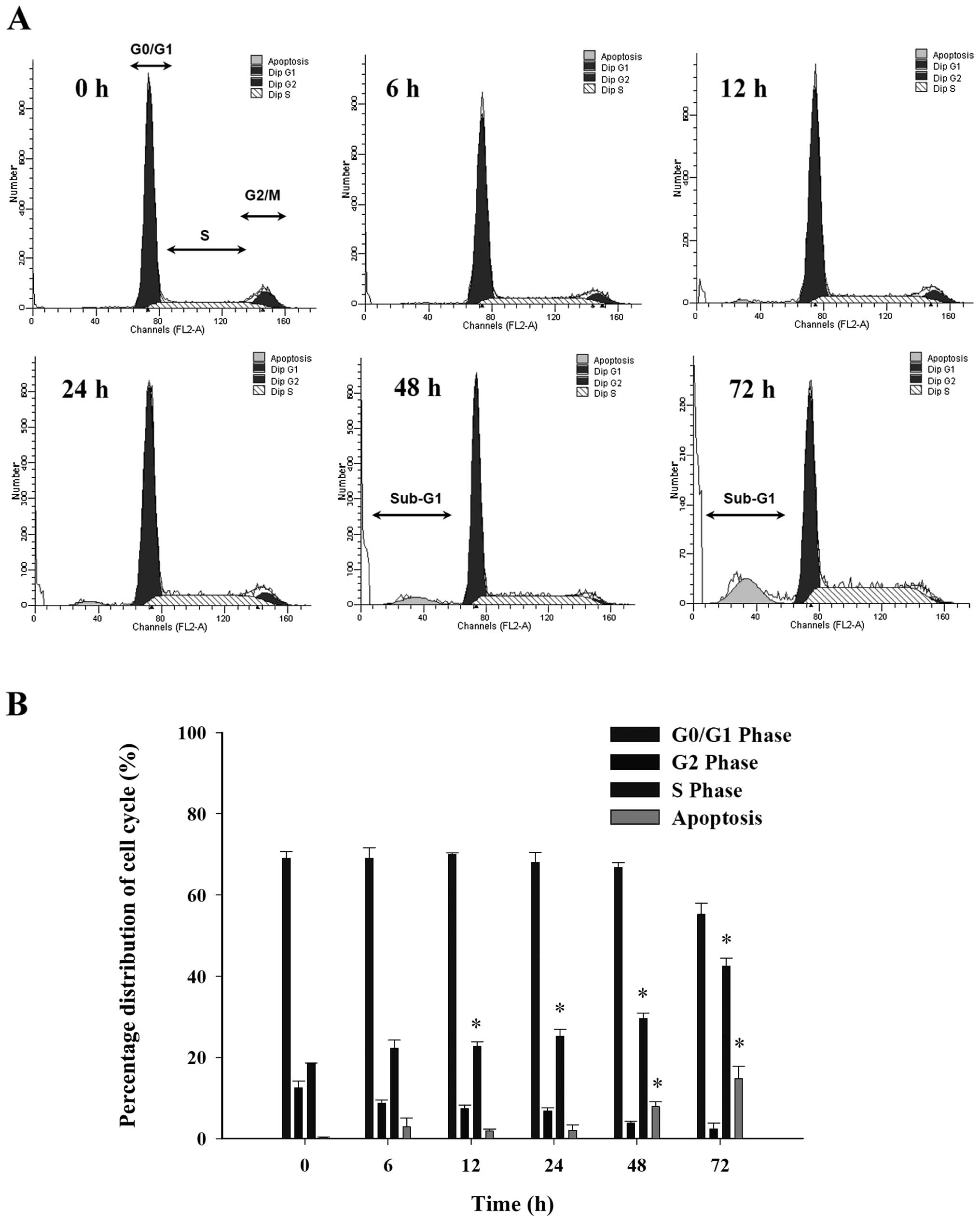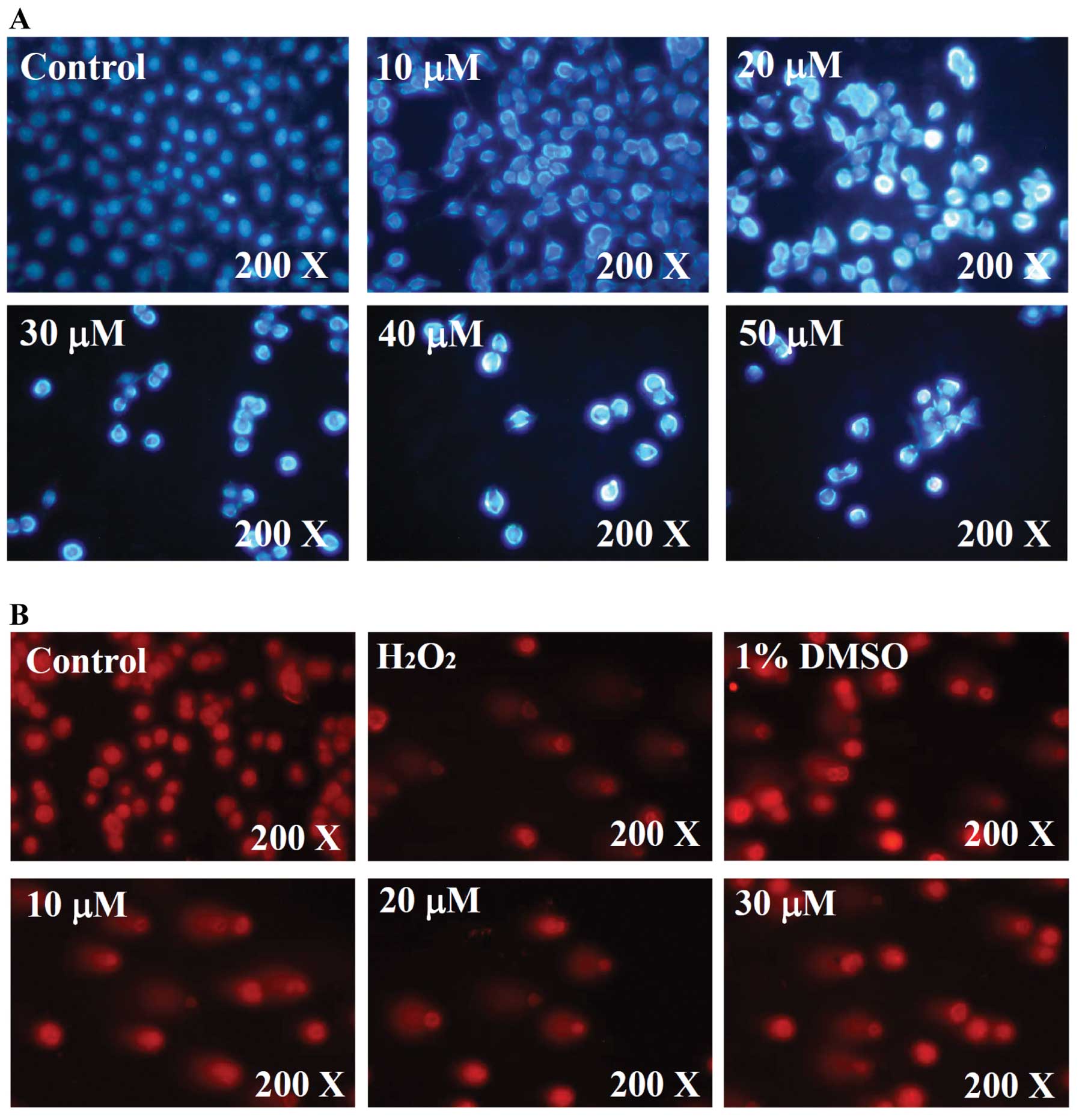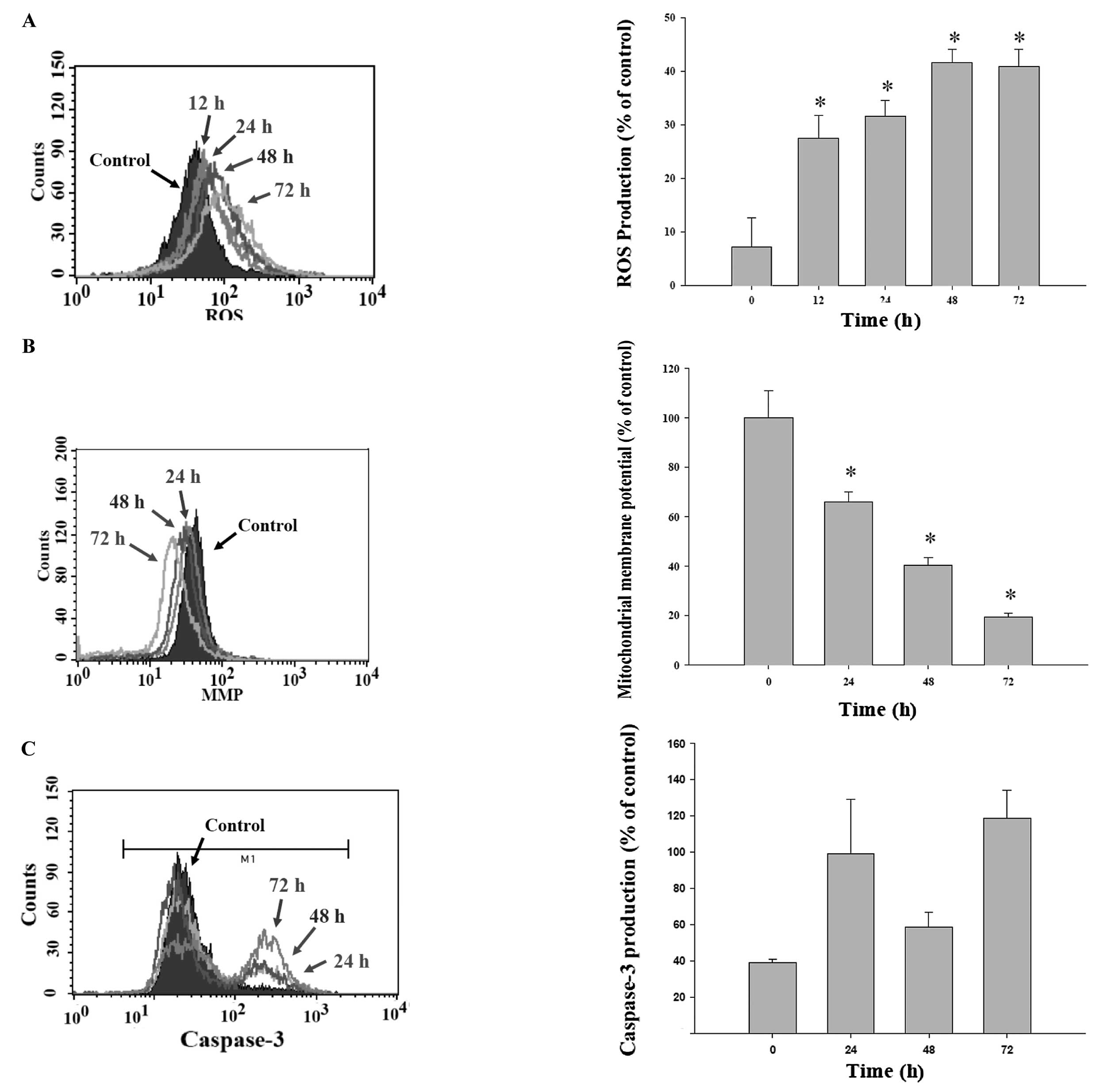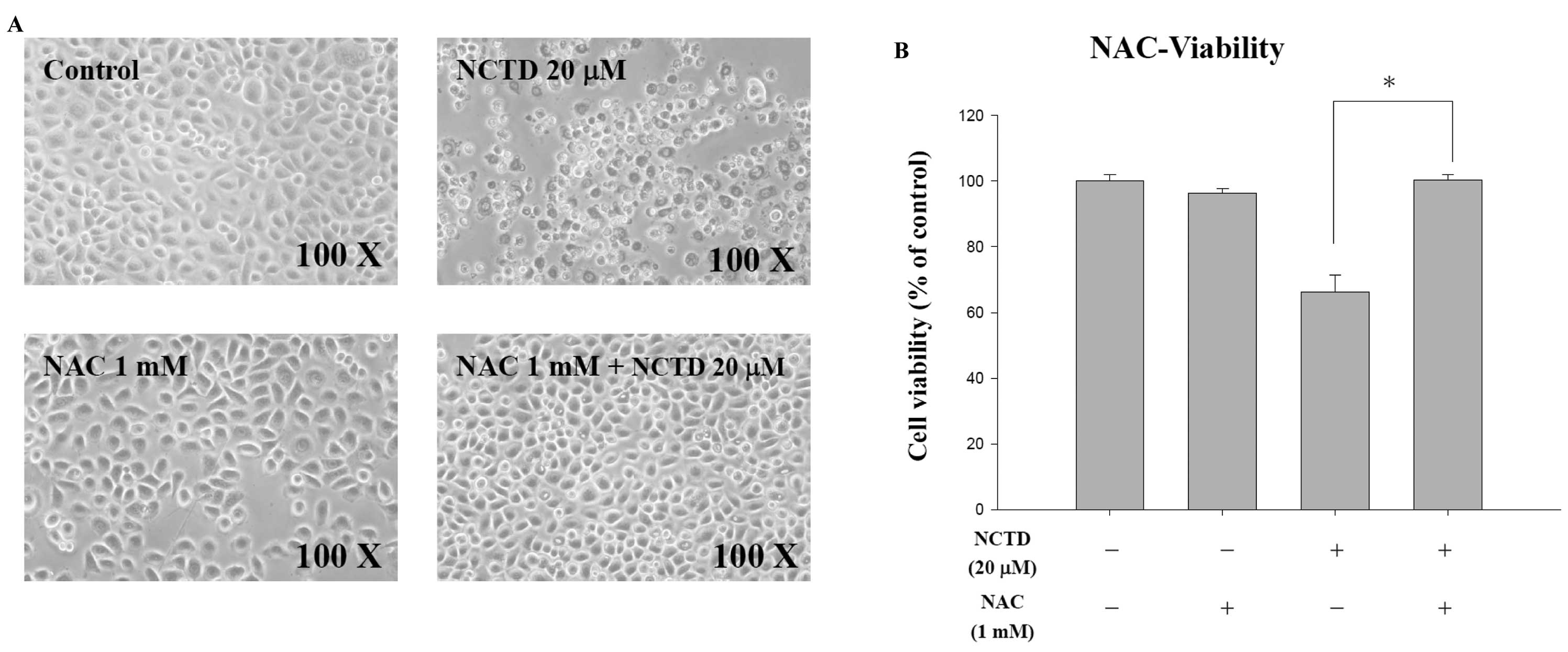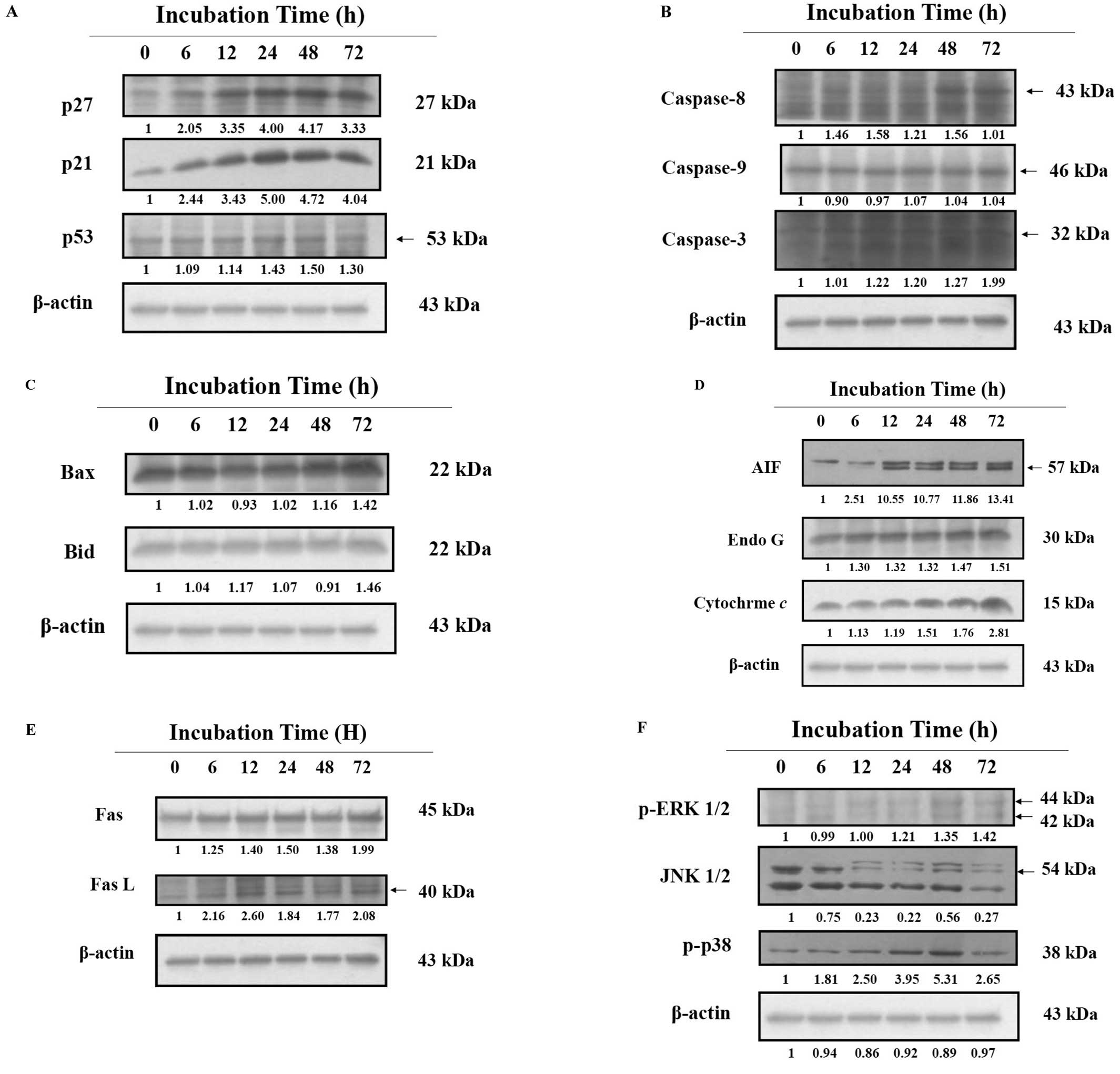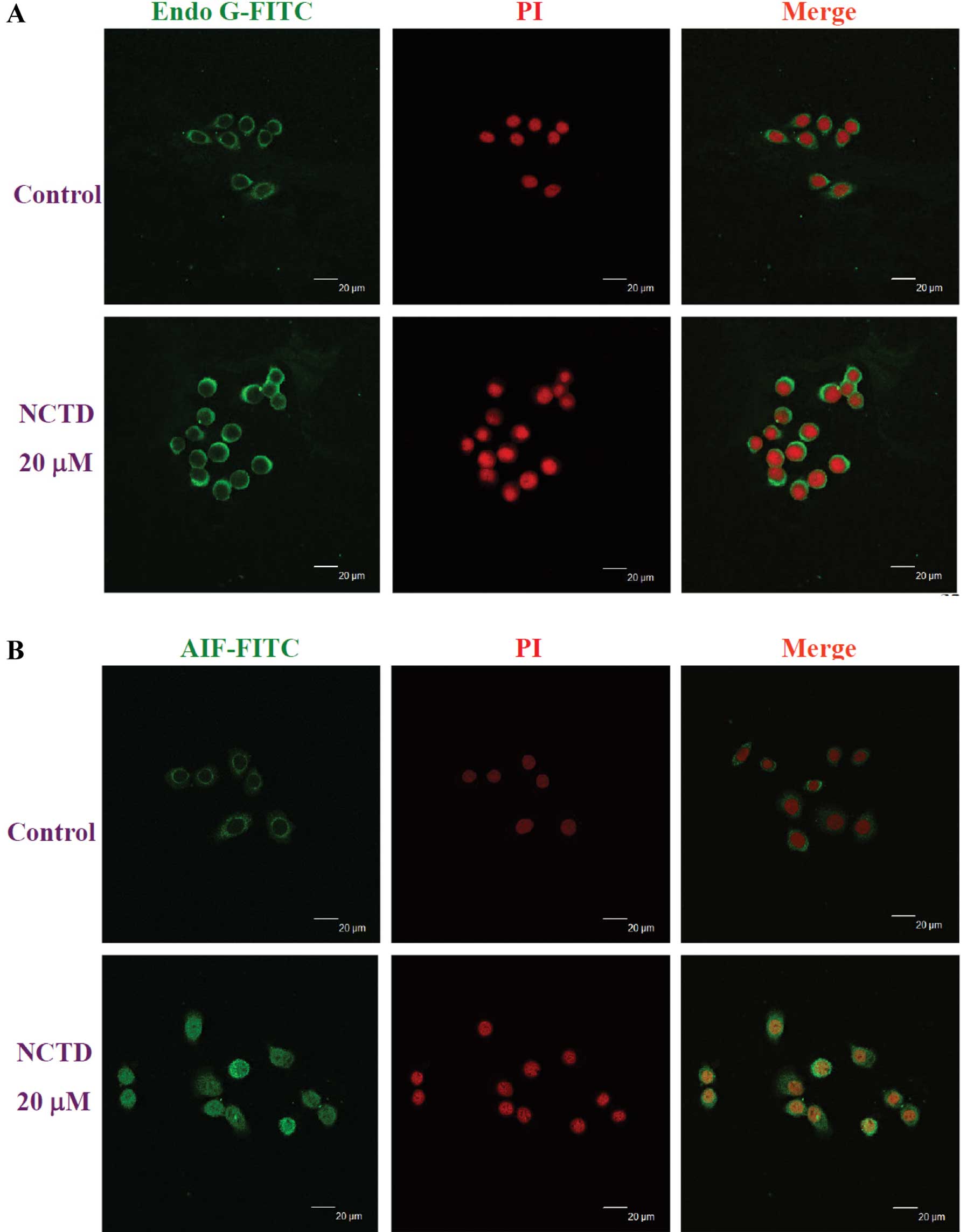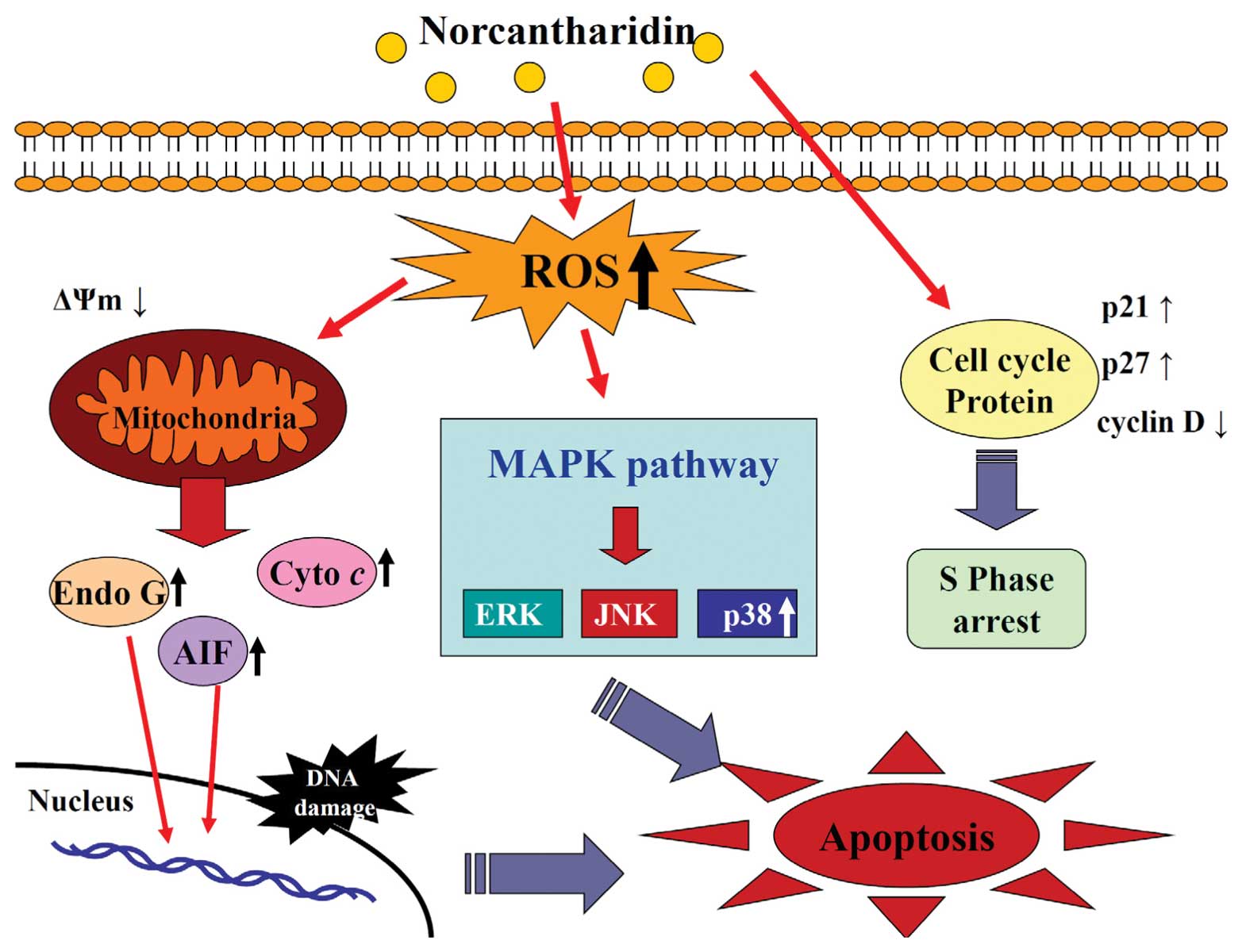|
1.
|
Chen RJ, Ho CT and Wang YJ: Pterostilbene
induces autophagy and apoptosis in sensitive and chemoresistant
human bladder cancer cells. Mol Nutr Food Res. 54:1819–1832. 2010.
View Article : Google Scholar : PubMed/NCBI
|
|
2.
|
Singh RP, Dhanalakshmi S and Agarwal R:
Phytochemicals as cell cycle modulators - a less toxic approach in
halting human cancers. Cell Cycle. 1:156–161. 2002. View Article : Google Scholar : PubMed/NCBI
|
|
3.
|
Degterev A, Boyce M and Yuan J: A decade
of caspases. Oncogene. 22:8543–8567. 2003. View Article : Google Scholar : PubMed/NCBI
|
|
4.
|
Ziegler DS and Kung AL: Therapeutic
targeting of apoptosis pathways in cancer. Curr Opin Oncol.
20:97–103. 2008. View Article : Google Scholar : PubMed/NCBI
|
|
5.
|
Klein S, McCormick F and Levitzki A:
Killing time for cancer cells. Nat Rev Cancer. 5:573–580. 2005.
View Article : Google Scholar
|
|
6.
|
Kao ST, Yeh CC, Hsieh CC, et al: The
Chinese medicine Bu-Zhong-Yi-Qi-Tang inhibited proliferation of
hepatoma cell lines by inducing apoptosis via G0/G1 arrest. Life
Sci. 69:1485–1496. 2001. View Article : Google Scholar : PubMed/NCBI
|
|
7.
|
Gamet-Payrastre L, Li P, Lumeau S, et al:
Sulforaphane, a naturally occurring isothiocyanate, induces cell
cycle arrest and apoptosis in HT29 human colon cancer cells. Cancer
Res. 60:1426–1433. 2000.PubMed/NCBI
|
|
8.
|
Wang GS: Medical uses of mylabris in
ancient China and recent studies. J Ethnopharmacol. 26:147–162.
1989. View Article : Google Scholar : PubMed/NCBI
|
|
9.
|
Peng F, Wei YQ, Tian L, et al: Induction
of apoptosis by norcantharidin in human colorectal carcinoma cell
lines: involvement of the CD95 receptor/ligand. J Cancer Res Clin
Oncol. 128:223–230. 2002. View Article : Google Scholar : PubMed/NCBI
|
|
10.
|
Huang Y, Liu Q, Liu K, Yagasaki K and
Zhang G: Suppression of growth of highly-metastatic human breast
cancer cells by norcantharidin and its mechanisms of action.
Cytotechnology. 59:2092009. View Article : Google Scholar
|
|
11.
|
Chen YN, Chen JC, Yin SC, et al: Effector
mechanisms of norcantharidin-induced mitotic arrest and apoptosis
in human hepatoma cells. Int J Cancer. 100:158–165. 2002.
View Article : Google Scholar : PubMed/NCBI
|
|
12.
|
Fan YZ, Zhao ZM, Fu JY and Chen CQ:
Anti-tumor mechanism of norcantharidin for the implanted tumors of
human gallbladder carcinoma in nude mice in vivo. Zhonghua Wai Ke
Za Zhi. 44:618–622. 2006.(In Chinese).
|
|
13.
|
Chang C, Zhu YQ, Mei JJ, Liu SQ and Luo J:
Involvement of mitochondrial pathway in NCTD-induced cytotoxicity
in human hepG2 cells. J Exp Clin Cancer Res. 29:1452010. View Article : Google Scholar : PubMed/NCBI
|
|
14.
|
Luan J, Duan H, Liu Q, Yagasaki K and
Zhang G: Inhibitory effects of norcantharidin against human lung
cancer cell growth and migration. Cytotechnology. 62:349–355. 2010.
View Article : Google Scholar : PubMed/NCBI
|
|
15.
|
Chen YJ, Tsai YM, Kuo CD, Ku KL, Shie HS
and Liao HF: Norcantharidin is a small-molecule synthetic compound
with anti-angiogenesis effect. Life Sci. 85:642–651. 2009.
View Article : Google Scholar : PubMed/NCBI
|
|
16.
|
Kok SH, Cheng SJ, Hong CY, et al:
Norcantharidin-induced apoptosis in oral cancer cells is associated
with an increase of proapoptotic to antiapoptotic protein ratio.
Cancer Lett. 217:43–52. 2005. View Article : Google Scholar : PubMed/NCBI
|
|
17.
|
Kok SH, Hong CY, Kuo MY, et al:
Comparisons of norcantharidin cytotoxic effects on oral cancer
cells and normal buccal keratinocytes. Oral Oncol. 39:19–26. 2003.
View Article : Google Scholar : PubMed/NCBI
|
|
18.
|
Peng C, Liu X, Liu E, et al:
Norcantharidin induces HT-29 colon cancer cell apoptosis through
the alphavbeta6-extracellular signal-related kinase signaling
pathway. Cancer Sci. 100:2302–2308. 2009. View Article : Google Scholar : PubMed/NCBI
|
|
19.
|
Lu CC, Yang JS, Huang AC, et al:
Chrysophanol induces necrosis through the production of ROS and
alteration of ATP levels in J5 human liver cancer cells. Mol Nutr
Food Res. 54:967–976. 2010. View Article : Google Scholar : PubMed/NCBI
|
|
20.
|
Chiang JH, Yang JS, Ma CY, et al:
Danthron, an anthraquinone derivative, induces DNA damage and
caspase cascades-mediated apoptosis in SNU-1 human gastric cancer
cells through mitochondrial permeability transition pores and
Bax-triggered pathways. Chem Res Toxicol. 24:20–29. 2011.
View Article : Google Scholar
|
|
21.
|
Kuo JH, Chu YL, Yang JS, et al:
Cantharidin induces apoptosis in human bladder cancer TSGH 8301
cells through mitochondria-dependent signal pathways. Int J Oncol.
37:1243–1250. 2010.PubMed/NCBI
|
|
22.
|
Saile B, Eisenbach C, El-Armouche H,
Neubauer K and Ramadori G: Antiapoptotic effect of interferon-alpha
on hepatic stellate cells (HSC): a novel pathway of IFN-alpha
signal transduction via Janus kinase 2 (JAK2) and caspase-8. Eur J
Cell Biol. 82:31–41. 2003. View Article : Google Scholar : PubMed/NCBI
|
|
23.
|
Lee YJ, Song JJ, Kim JH, Kim HR and Song
YK: Low extracellular pH augments TRAIL-induced apoptotic death
through the mitochondria-mediated caspase signal transduction
pathway. Exp Cell Res. 293:129–143. 2004. View Article : Google Scholar : PubMed/NCBI
|
|
24.
|
Kikuchi T, Akazawa H, Tabata K, et al:
3-O-(E)-p-coumaroyl tormentic acid from Eriobotrya japonica leaves
induces caspase-dependent apoptotic cell death in human leukemia
cell line. Chem Pharm Bull (Tokyo). 59:378–381. 2011. View Article : Google Scholar : PubMed/NCBI
|
|
25.
|
Glick RD, Swendeman SL, Coffey DC, et al:
Hybrid polar histone deacetylase inhibitor induces apoptosis and
CD95/CD95 ligand expression in human neuroblastoma. Cancer Res.
59:4392–4399. 1999.PubMed/NCBI
|
|
26.
|
Boldin MP, Goncharov TM, Goltsev YV and
Wallach D: Involvement of MACH, a novel MORT1/FADD-interacting
protease, in Fas/APO-1- and TNF receptor-induced cell death. Cell.
85:803–815. 1996. View Article : Google Scholar : PubMed/NCBI
|
|
27.
|
Liu KC, Huang YT, Wu PP, et al: The roles
of AIF and Endo G in the apoptotic effects of benzyl isothiocyanate
on DU 145 human prostate cancer cells via the mitochondrial
signaling pathway. Int J Oncol. 38:787–796. 2011.PubMed/NCBI
|
|
28.
|
Huan SK, Lee HH, Liu DZ, Wu CC and Wang
CC: Cantharidin-induced cytotoxicity and cyclooxygenase 2
expression in human bladder carcinoma cell line. Toxicology.
223:136–143. 2006. View Article : Google Scholar : PubMed/NCBI
|
|
29.
|
Rauh R, Kahl S, Boechzelt H, Bauer R,
Kaina B and Efferth T: Molecular biology of cantharidin in cancer
cells. Chin Med. 2:82007. View Article : Google Scholar : PubMed/NCBI
|
|
30.
|
Adams JM and Cory S: The Bcl-2 protein
family: arbiters of cell survival. Science. 281:1322–1326. 1998.
View Article : Google Scholar : PubMed/NCBI
|
|
31.
|
Zhang R, Humphreys I, Sahu RP, Shi Y and
Srivastava SK: In vitro and in vivo induction of apoptosis by
capsaicin in pancreatic cancer cells is mediated through ROS
generation and mitochondrial death pathway. Apoptosis.
13:1465–1478. 2008. View Article : Google Scholar : PubMed/NCBI
|
|
32.
|
Ott M, Gogvadze V, Orrenius S and
Zhivotovsky B: Mitochondria, oxidative stress and cell death.
Apoptosis. 12:913–922. 2007. View Article : Google Scholar : PubMed/NCBI
|



